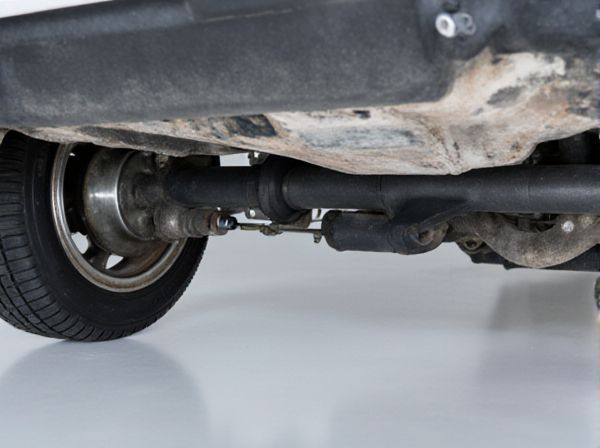
Photo illustration: Steer axle vs Drive axle
The steer axle controls the direction of the vehicle and supports the front weight, while the drive axle transmits power from the engine to the wheels, providing propulsion. You rely on the steer axle for precise handling and on the drive axle for traction and movement. Proper maintenance of both axles ensures vehicle stability and performance.
Table of Comparison
| Feature | Steer Axle | Drive Axle |
|---|---|---|
| Primary Function | Controls vehicle steering | Delivers engine power to wheels |
| Location | Front of the vehicle | Rear or middle of the vehicle |
| Wheel Movement | Allows wheel turning | Fixed wheels, no turning |
| Load Bearing | Supports front axle load | Supports driven axle load |
| Components | Includes steering knuckles, tie rods | Includes differential, drive shafts |
| Torque Transmission | Does not transmit torque | Transmits engine torque to wheels |
| Common Applications | Used in all vehicles for directional control | Used in rear-wheel drive, 4WD, AWD vehicles |
Introduction to Steer Axle and Drive Axle
The steer axle is the front axle of a vehicle responsible for directing the wheels to control steering and maneuverability, playing a crucial role in vehicle stability and safety. The drive axle transmits power from the engine to the wheels, enabling movement by transferring torque to the rear or front wheels depending on the drivetrain configuration. Understanding the functions of steer and drive axles is essential for optimizing vehicle performance and handling characteristics.
Key Functions of Steer Axle
The steer axle is responsible for providing directional control and stability to vehicles by enabling smooth and precise turning. It supports a significant portion of the vehicle's weight, especially the front end, and houses critical components such as steering knuckles, tie rods, and suspension systems that facilitate accurate wheel alignment. Unlike the drive axle, which transmits power to the wheels, the steer axle primarily manages steering input and load distribution essential for safe handling.
Main Roles of Drive Axle
The drive axle is primarily responsible for transmitting power from the engine to the wheels, enabling vehicle movement and providing traction. It supports the vehicle's weight while handling torque and rotational forces necessary for propulsion. Unlike the steer axle, which mainly facilitates directional control and steering, the drive axle ensures effective power delivery and stability during acceleration.
Structural Differences: Steer Axle vs Drive Axle
Steer axles feature a simpler suspension design with pivot points and kingpins, allowing wheels to turn and steer the vehicle, while drive axles incorporate a differential and axle shafts to transmit engine power directly to the wheels. Structurally, steer axles are lighter and designed to handle lateral forces for turning, whereas drive axles are heavier and built for torque transfer and traction under load. The drive axle housing is often larger and reinforced to accommodate gears and shafts, contrasting with the more streamlined construction of steer axles.
Components Comparison: Steer vs Drive Axles
Steer axles primarily consist of components such as kingpins, spindle assemblies, and tie rods that enable directional control and pivotal movement for steering. Drive axles include heavy-duty components like differential gears, axle shafts, and drive bearings designed to transmit engine torque to the wheels and support vehicle propulsion. The structural design of steer axles prioritizes maneuverability and load distribution, while drive axles emphasize torque transfer and traction under various driving conditions.
Impact on Vehicle Handling and Performance
Steer axles directly influence vehicle handling by controlling the direction and responsiveness of the front wheels, crucial for precise steering and stability. Drive axles affect performance by transmitting engine power to the wheels, impacting traction, acceleration, and load distribution, especially in varying road conditions. Proper balance between steer and drive axles ensures optimized vehicle control, improved safety, and enhanced operational efficiency.
Maintenance Requirements for Steer and Drive Axles
Steer axles require regular inspection and maintenance of tie rods, kingpins, and wheel bearings to ensure precise steering control and prevent uneven tire wear. Drive axles demand frequent monitoring of differential fluid levels, universal joints, and axle seals to maintain power transmission efficiency and avoid costly drivetrain failures. Proper lubrication and timely replacement of worn components in both steer and drive axles are critical for vehicle safety and optimal performance.
Common Issues and Solutions
Steer axles frequently face issues such as uneven tire wear and steering system misalignment, often caused by worn ball joints or tie rods, which can be resolved by regular alignment checks and timely replacement of damaged components. Drive axles commonly suffer from differential leaks and CV joint failures, requiring inspection of seals and boots along with periodic lubrication and prompt repair to maintain axle performance. Proper maintenance of both steer and drive axles enhances vehicle handling, reduces premature wear, and ensures overall drivetrain reliability.
Applications in Different Vehicle Types
Steer axles are primarily used in passenger cars, buses, and light trucks to control vehicle direction and improve maneuverability, while drive axles are essential in heavy-duty trucks and off-road vehicles, providing the necessary traction and power transfer to the wheels. In commercial vehicles like tractor-trailers, steer axles handle steering loads on the front, whereas drive axles distribute engine torque to the rear wheels for propulsion. Specialized vehicles such as all-wheel-drive SUVs and construction equipment integrate both steer and drive axles to enhance stability, traction, and control under diverse operating conditions.
Choosing Between Steer Axle and Drive Axle
Choosing between a steer axle and a drive axle depends primarily on vehicle function and performance requirements; steer axles provide directional control and are typically located at the front of the vehicle, while drive axles transmit engine power to the wheels, enabling movement and traction. Factors such as load capacity, maneuverability, terrain conditions, and drivetrain configuration influence the selection process. Understanding the specific weight distribution and traction needs ensures optimal vehicle handling and efficiency when deciding between a steer axle and a drive axle.
 caratoz.com
caratoz.com